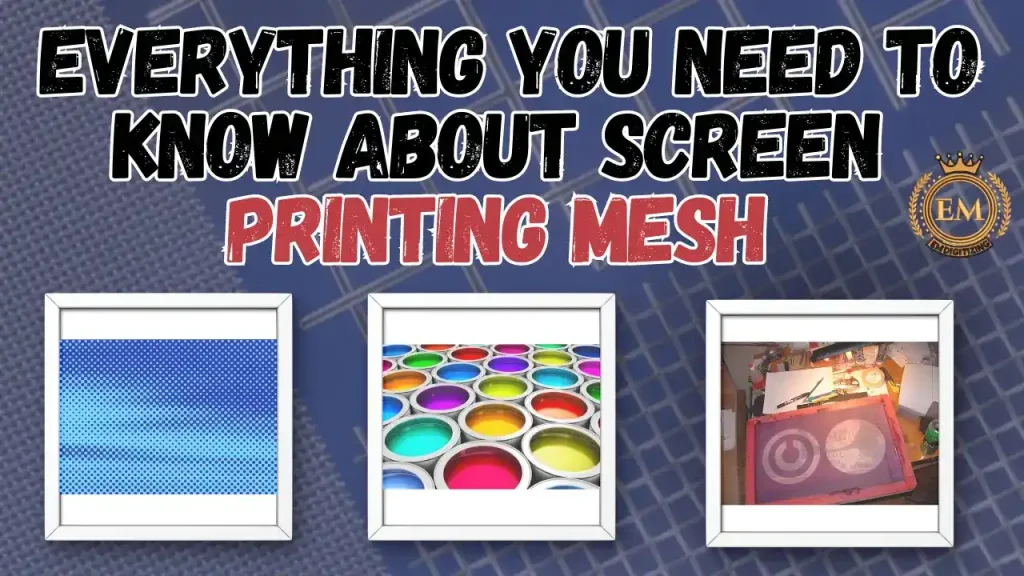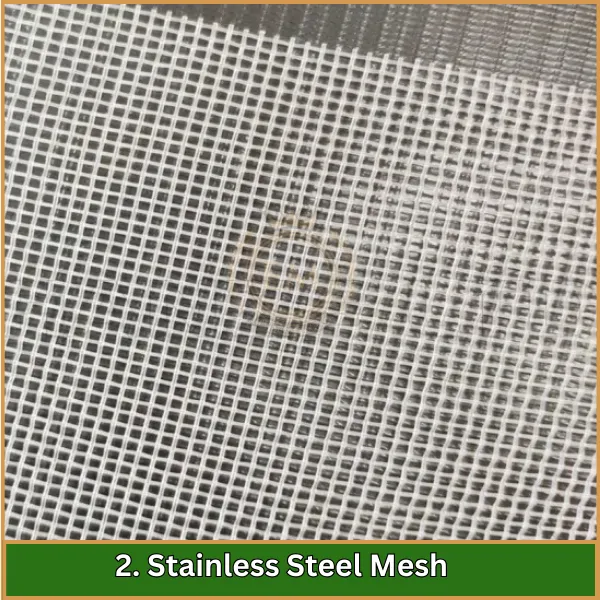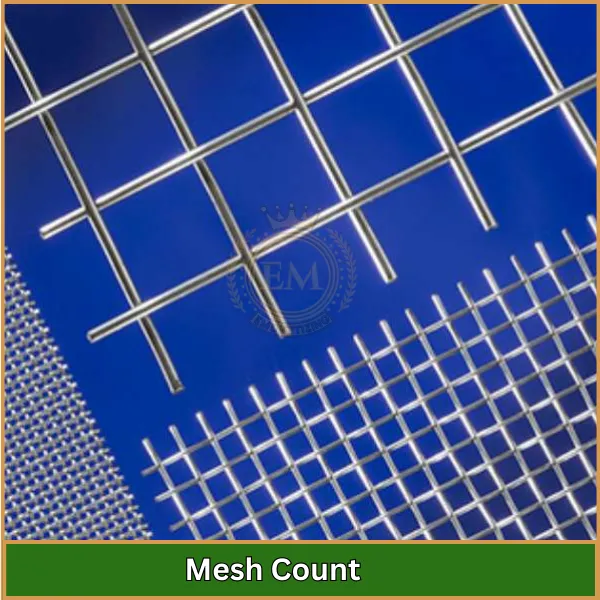When it comes to screen printing, the type of mesh you use can greatly affect the outcome of your design. Screen printing mesh determines how much ink goes through and how fine your design details will appear.
Using the correct mesh helps ensure your prints come out clear and vibrant.In this guide, we’ll cover the basics of different mesh types, how to choose the right one, and some simple care tips to keep your screens in good condition.

By mastering these details, you’ll be able to achieve better printing results.
Everything You Need to Know About Screen Printing Mesh
What is Screen Printing Mesh?
It is a finely woven fabric that serves as a stencil in the screen printing process, used for transferring ink onto different surfaces like fabric, paper, glass, and metal. It allows ink to pass through open areas while preventing it from reaching parts of the surface not meant for printing. The mesh is stretched tightly over a frame, and the mesh count and material type influence the quantity of ink applied and the precision of the printed details.
What are the Types of Screen Mesh for Printing?
It comes in various types, each suited for different printing needs based on the material and mesh count. These differences affect ink deposition, image detail, and overall print quality.
The types are:
- Polyester Mesh
- Stainless Steel Mesh
- Nylon Mesh
- Silk Mesh
1. Polyester Mesh

Polyester mesh is a synthetic fabric commonly used in screen mesh for printing due to its strength and chemical resistance.
Key Features:
- High tensile strength and durability
- Resistant to chemical degradation
Uses:
- Ideal for printing on textiles, ceramics, and flat or cylindrical products.
Benefits:
- Polyester mesh is affordable and versatile, suitable for a variety of printing jobs.
Limitations:
- It can stretch more under high tension, which may affect print registration.
2. Stainless Steel Mesh

Stainless steel mesh is a highly durable mesh screen print made from metal wires, used for its resistance to heat and chemicals.
Key Features:
- Extremely durable and strong
- High resistance to heat and harsh chemicals
Uses:
- Used in electronics, glass printing, and applications requiring precise ink deposit control.
Benefits:
- Excellent for high-precision prints and offers superior durability.
Limitations:
- More expensive compared to other types of screen printing mesh.
3. Nylon Mesh

Nylon mesh is a flexible and stretchable fabric, favored for its adaptability to irregular surfaces.
Key Features:
- High flexibility and stretchability
- Good abrasion resistance
Uses:
- Suitable for irregular surfaces and abrasive substrates like glass and ceramics.
Benefits:
- Adapts well to uneven surfaces, providing more versatility.
Limitations:
- Less solvent-resistant than polyester, which may limit its use with certain inks.
4. Silk Mesh

Silk mesh is a traditional material used in print screen mesh for its ability to detail fine artwork, primarily used in high-quality printmaking.
Key Features:
- Traditional material for screen printing
- Fine detail capability
Uses:
- Mostly used in artistic, high-quality printmaking and limited industrial applications.
Benefits:
- Excellent for creating detailed artworks with a high-quality finish.
Limitations:
- Not as durable as synthetic materials and sensitive to environmental conditions, requiring more careful handling.
What is Screen Printing Mesh Count?
Mesh count refers to the number of threads per inch in a printing mesh. This measurement is crucial as it directly impacts the resolution, ink deposition, and the level of detail achievable in the printing process.
Higher mesh counts mean finer threads and smaller openings, which are great for detailed designs and thin ink layers. Conversely, lower mesh counts have larger openings, suitable for thicker inks and bolder graphics.
Common Types of Mesh Count and Their Applications
Mesh Count | Description | Common Applications |
32T | Low mesh count, allows for more ink deposition, ideal for bold designs. | Specialty inks like glitter or flakes. |
43T | Low mesh count, good for heavy ink deposits. | Textile printing with excellent coverage. |
55T | Low mesh count, balances coverage and definition. | Textile printing and general applications. |
64T | Medium mesh count, suitable for various materials. | Printing on textiles, paper, and cardboard. |
77T | Medium mesh count, good for finer details. | Lightweight garments and paper printing. |
90T | Commonly used for higher detail designs. | Top layer prints on fabric and paper. |
110T | Versatile mesh count, suitable for bold designs. | T-shirt printing and general-purpose screen printing. |
156T | Medium mesh count, balances detail and ink coverage. | Textile printing with moderate detail and bold colors. |
230T | High mesh count, ideal for fine details and thin inks. | High-resolution prints on lighter fabrics and paper. |
305T | Very high mesh count, allows for intricate designs. | Detailed artwork and halftones on smooth surfaces. |
Impact of Mesh Count on Printing
The mesh count in screen printing plays a critical role in determining the quality and characteristics of the final print. Essentially, it affects three major aspects of printing: resolution, ink deposition, and the texture of the print.
- Resolution: A higher mesh count, with more threads per inch, results in a finer mesh. This allows for printing finer details because it can hold smaller dots of ink. It is ideal for intricate designs or small text that requires high precision.
- Ink Deposition: The amount of ink that passes through the mesh to the substrate varies with the mesh count. Lower mesh counts have larger openings, which permit a greater volume of ink to pass through, creating a denser and more opaque print. This is particularly beneficial for bold designs or when using specialty inks like metallic or glitter.
- Texture of the Print: The texture of the final print can also be influenced by the mesh count. Coarser mesh (lower mesh count) generally results in a thicker ink layer, which can add a noticeable texture to the print. Conversely, higher mesh counts lay down a thinner ink layer, which can be smoother to the touch.
These factors collectively contribute to the versatility of mesh printing screen techniques, allowing for customization according to the specific needs of the print job, from detailed artistic images to robust commercial designs.
Considerations for Selecting Screen Printing Mesh
When choosing the right mesh for screen printing, several factors need to be evaluated to ensure optimal print quality and efficiency.
Material Type
The material of the mesh can influence its durability, ink compatibility, and print quality. Common materials include polyester, nylon, and stainless steel, each offering different benefits depending on the printing application.
Mesh Count

Selecting the appropriate mesh count is crucial as it affects the resolution and the amount of ink deposited. Higher mesh counts are used for detailed prints on smooth surfaces, while lower counts are better for bold prints on rough surfaces.
Thread Diameter
The diameter of the threads in the mesh can affect the overall ink deposit and the detail of the print. Finer threads provide detailed prints with less ink deposit, suitable for high-detail designs.
Mesh Tension
Proper mesh tension is essential to avoid issues like blurry prints or uneven ink distribution. Higher tension typically results in better print quality.
Mesh Color
Mesh color can impact the exposure times during the screen making process and ultimately affect the print. White mesh offers lower exposure times, suitable for finer details, whereas yellow or orange mesh helps with sharper images and is better for very fine detailed work.
Maintenance and Cleaning Tips for Screen Printing Mesh
To preserve the quality and extend the life of your printing mesh, proper care and cleaning are essential. Here are some straightforward guidelines to follow:
- Regular Cleaning: Clean the mesh promptly after each use to prevent ink from drying and clogging the mesh openings.
- Gentle Handling: When cleaning, use soft brushes or sponges to avoid damaging the mesh threads.
- Specific Chemicals: Choose cleaning solutions specifically designed for meshes, ensuring they effectively remove ink without damaging the fabric.
- Thorough Rinsing: Always rinse the mesh thoroughly with water after cleaning to eliminate any remaining cleaner or ink.
- Proper Drying: Ensure the mesh is completely dry before storing it in a clean, dry area to avoid issues with mold or mildew.
Following these tips will help maintain the performance of your printing mesh and achieve consistently high-quality prints.
Conclusion
Choosing the right screen printing mesh can make a big difference in the quality of your prints. By understanding how mesh impacts ink flow and design details, you can achieve clearer, more professional results. Proper care and maintenance will also help extend the life of your screens and keep your prints looking sharp.
Looking to enhance your screen printing projects? EMDigitizing offers expert vector art services designed to fit your needs. With fast turnaround times, affordable prices, and high-quality work, we ensure your designs are ready for print with precision. Plus, enjoy a 50% discount on your first order! Let us help you take your printing to the next level.
FAQs
Yes, you can screen print on mesh shorts, but it’s important to adjust the off-contact distance properly. Using a backing material can also help prevent ink from bleeding through the mesh.
Choosing the right mesh count depends on the complexity of the design and the type of ink. Higher mesh counts are ideal for finer details and thinner inks, while lower counts work better for bold designs and thicker inks.
To clean screen print mesh, apply a screen wash or emulsion remover, scrub gently with a soft brush to loosen any ink or residue, and then rinse thoroughly with water.
To expose screen printing mesh, coat the screen with a light-sensitive emulsion and let it dry. Then, place your design on the screen and expose it to a UV light source for the recommended amount of time, depending on your emulsion type.
